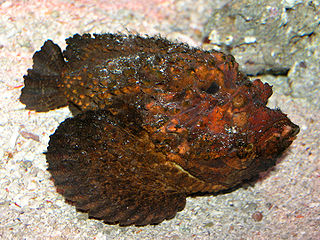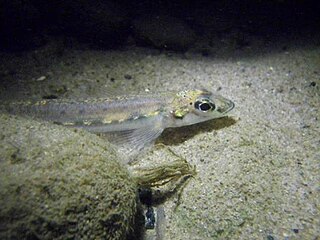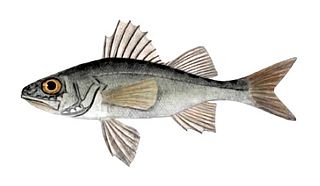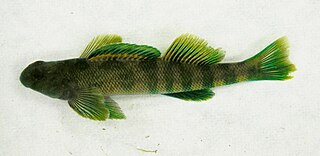
The walleye, also called the yellow pike or yellow pikeperch or yellow pickerel, is a freshwater perciform fish native to most of Canada and to the Northern United States. It is a North American close relative of the European zander, also known as the pikeperch. The walleye is sometimes called the yellow walleye to distinguish it from the blue walleye, which is a color morph that was once found in the southern Ontario and Quebec regions, but is now presumed extinct. However, recent genetic analysis of a preserved (frozen) 'blue walleye' sample suggests that the blue and yellow walleye were simply phenotypes within the same species and do not merit separate taxonomic classification.

The Percidae are a family of ray-finned fish, part of the order Perciformes, which are found in fresh and brackish waters of the Northern Hemisphere. The majority are Nearctic, but there are also Palearctic species. The family contains more than 200 species in 11 genera. The perches and their relatives are in this family; well-known species include the walleye, sauger, ruffe, and three species of perch. However, small fish known as darters are also a part of this family.

The zander, sander or pikeperch, is a species of ray-finned fish from the family Percidae, which also includes perch, ruffe and darter. It is found in freshwater and brackish habitats in western Eurasia. It is a popular game fish and has been introduced to a variety of localities outside its native range. It is the type species of the genus Sander.

The sauger is a freshwater perciform fish of the family Percidae that resembles its close relative, the walleye. The species is a member of the largest vertebrate order, the Perciformes. It is the most migratory percid species in North America. Saugers have two dorsal fins; the first is spiny and the posterior dorsal fin is soft-rayed. Their paired fins are in the thoracic position and their caudal fin is truncated, which means squared off at the corners, a characteristic of the family Percidae. Another physical characteristic of saugers is their ctenoid scales, which are common in advanced fishes. Saugers have a fusiform body structure, and as a result are well adapted predatory fishes and are capable of swimming into fast currents with minimal drag on their bodies. They may be distinguished from walleyes by the distinctly spotted dorsal fin, by the lack of a white splotch on the caudal fin, by the rough skin over their gills, and by their generally more brassy color, or darker color in some regions. The typical sauger is 300 to 400 g in weight.

Synanceiinae is a subfamily of venomous ray-finned fishes, waspfishes, which is classified as part of the family Scorpaenidae, the scorpionfishes and their relatives. These fishes are found in the Indo-Pacific oceans. They are primarily marine, though some species are known to live in fresh or brackish waters. The various species of this family are known informally as stonefish, stinger, stingfish and ghouls. Its species are known to have the most potent neurotoxins of all the fish venoms, secreted from glands at the base of their needle-like dorsal fin spines. The vernacular name, stonefish, for some of these fishes derives from their behaviour of camouflaging as rocks. The type species of the family is the estuarine stonefish.

Sander is a genus of predatory ray-finned fish in the family Percidae, which also includes the perches, ruffes, and darters. They are also known as "pike-perch" because of their resemblance to fish in the unrelated Esocidae (pike) family. They are the only genus in the monotypic tribe Luciopercini, which is one of two tribes in the subfamily Luciopercinae.

Romanichthys is a genus of ray-finned fish, one of two genera in the tribe Romanichthyini, which along with the tribe Luciopercini, forms the subfamily Luciopercinae of the family Percidae, alongside the perches, ruffes, and darters. The genus contains the single species Romanichthys valsanicola, known as the sculpin-perch, asprete, or Romanian darter.

Ammocrypta is a genus of freshwater ray-finned fish, commonly known as the sand darters, which is classified in the subfamily Etheostomatinae, part of the family Percidae which also includes the perches, ruffes and pikeperches. The species in the genus occur in eastern North America in Canada and the continental United States.

Crystallaria is a genus of freshwater ray-finned fish which is classified in the subfamily Etheostomatinae, commonly known as the darters, part of the family Percidae which also includes the perches, ruffes and pikeperches. They are found in the Mississippi River basin from Ohio to Minnesota and in southern Mississippi, northern Louisiana, and southeastern Oklahoma, and on the Gulf Slope of Escambia, Mobile Bay, and the Pearl River drainages. They have now been extirpated from Ohio, Kentucky, Indiana, and Illinois.

Gymnocephalus is a genus of ray-finned fishes from the family Percidae, which includes the perches, pike-perches and darters. They are from the Western Palearctic area, although one species, Gymnocephalus cernua has been accidentally introduced to the Great Lakes region where it is regarded as an invasive species. They have the common name "ruffe" and resemble the true perches in the genus Perca, but are usually smaller and have a different pattern.

Common percarina is a species of fish in the family Percidae. It is found in northwestern Black Sea basin in estuaries and coastal lakes, and in the lower reaches of the rivers that drain into that part of the Black Sea. It is a carnivorous species.

Percarina is a genus of ray-finned fish in the family Percidae found in eastern Europe. The genus is the only taxon in the monotypic subfamily Percarininae, which is characterised by having the first dorsal fin, having 9-11 spines and being widely separated from the second dorsal fin. They are thought to be closely related both to the perches of the genus Perca and to the ruffes of the genus Gymnocephalus.

The Volga pikeperch, or Volga zander, is a species of fish in the perch family Percidae. It is found in Austria, Azerbaijan, Bosnia and Herzegovina, Bulgaria, Croatia, Germany, Hungary, Moldova, Romania, Russia, Serbia, Slovakia, and Ukraine.

Zingel balcanicus, the Vardar streber is a species of freshwater ray-finned fish in the family Percidae, the perches, ruffes, pikeperches and the darters. This species is endemic to the Vardar or Axios River in North Macedonia and its distribution may extend to the lower reaches of the river in Greece. Its biology is little known but other species in the genus Zingel require turbulent flows.

Percoidea is a superfamily of fish of the order Perciformes. The superfamily includes about 3,374 species.
The emerald darter, is a species of freshwater ray-finned fish, a darter from the subfamily Etheostomatinae, part of the family Percidae, which also contains the perches, ruffes and pikeperches. It is found only in northern and eastern Kentucky and northeastern Tennessee.

Datnioides is a genus of ray-finned fish belonging to the family Lobotidae. These fishes are commonly known as tigerfish, tiger perch or freshwater tripletails. These fishes are found in the rivers of southern Asia and new Guinea.
Gymnocephalus ambriaelacus is a species of freshwater ray-finned fish, a ruffe, from the family Percidae which is endemic to Lake Ammersee, in the upper Danube basin in southern Germany. This species can reach a length is 11.7 centimetres (4.6 in) (SL). The species is classified as Critically Endangered as its population is declining following the introduction of the ruffe. Some authorities suggest that this taxon may be synonymous with the Balon's ruffe.

Romanichthyini is a tribe of freshwater ray-finned fish which is one of two tribes in the subfamily Luciopercinae, which in turn is classified under the family Percidae, the family also includes the perches, pikeperches, ruffes and darters.

Etheostomatinae is a species-rich subfamily of freshwater ray-finned fish, the members of which are commonly known as the darters. The subfamily is part of the family Percidae which also includes the perches, ruffes and pikeperches. The family is endemic to North America. It consists of three to five different genera and well over 200 species.
















